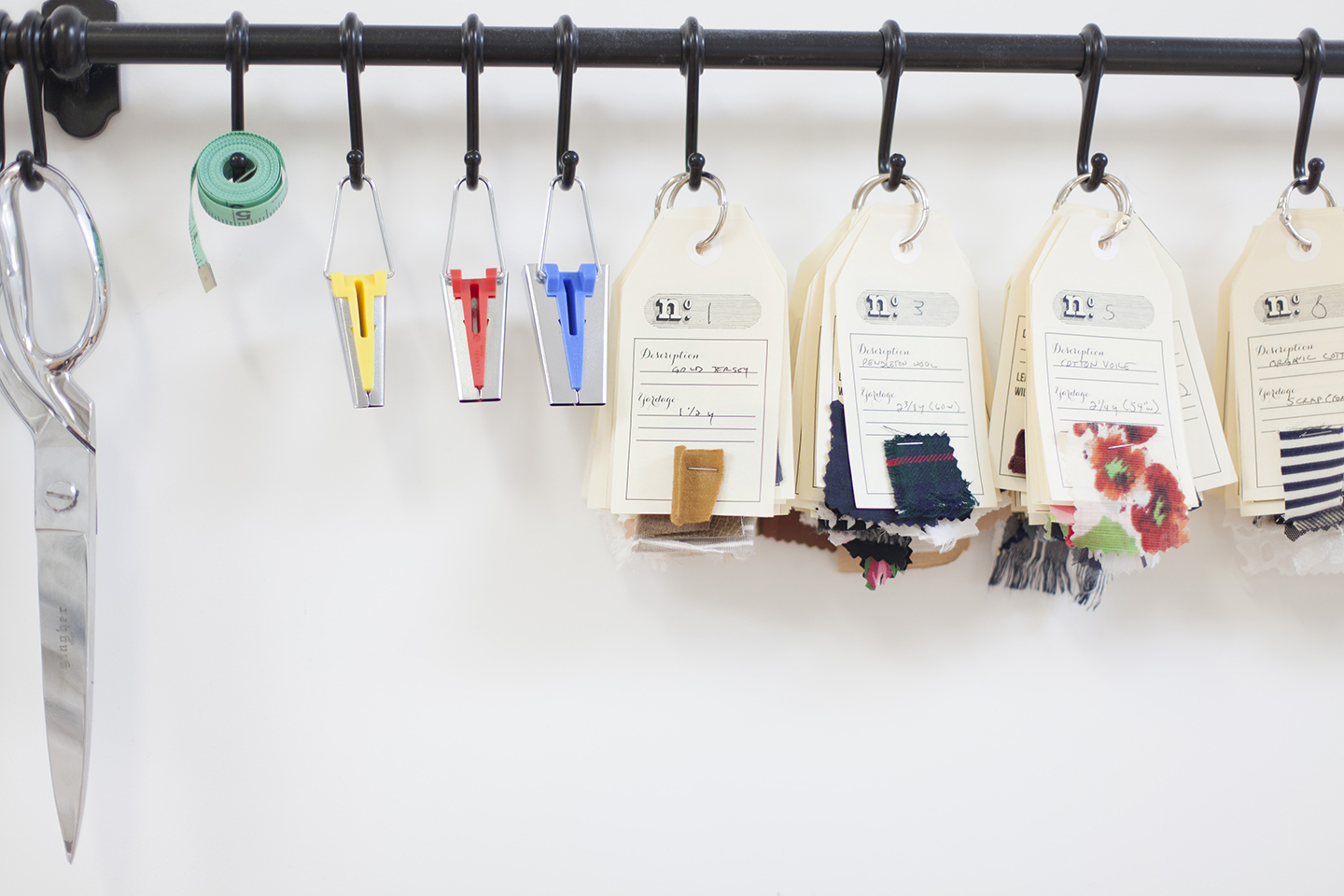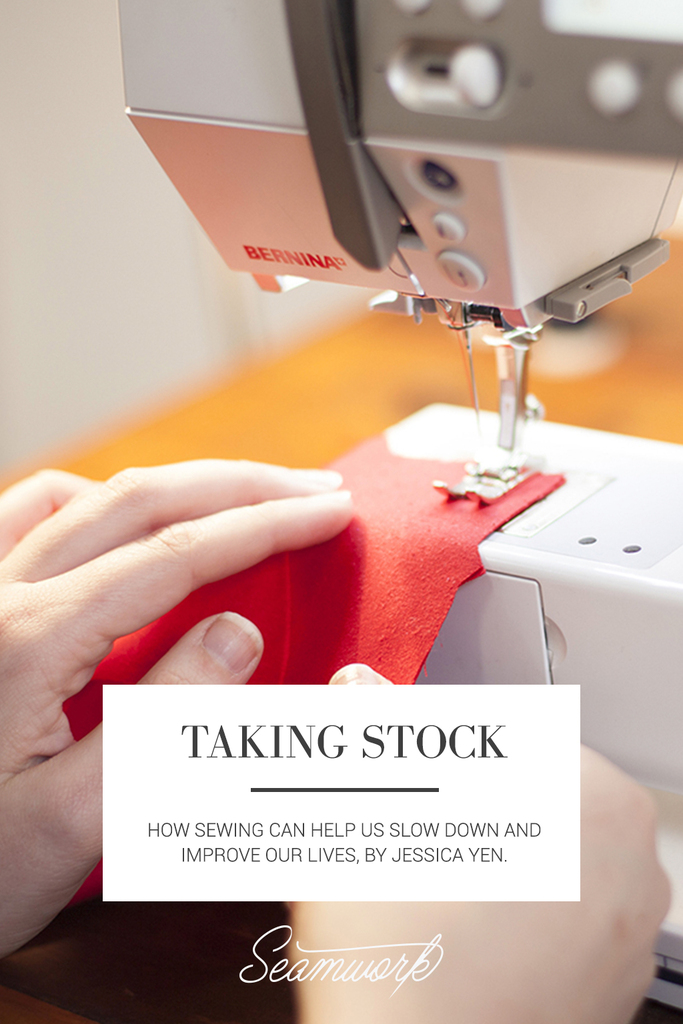
Despite my best intentions, there are days when life spins away from me before I can get my arms around it. Perpetually fifteen minutes late and unable to scratch those stubborn items off my to-do list, I sprint through my day. By the time I make it back to my apartment, my brain is a jumbled heap of errands, bills, emails awaiting responses, meals to plan, and then there’s that laundry lying in an unfolded heap at the foot of the bed. I know I’ve been busy, but have I done anything important? Like a car stuck in a single gear, I feel unbalanced. And yet there’s still that long list of chores…
Then I catch myself. Breathe. This is your night with the sewing machine, remember? Close your laptop. Steep a cup of tea. Fish out your latest project, load up a couple podcasts. By the time I’ve switched on the lamp near my sewing table and taken my first sip of tea, I can already feel my neck muscles beginning to unclench. The needle moves up and down in a soothing rhythm, and I fall into a steady pace: stitch, snip, stitch, snip, stitch, snip; press, press, press. A garment takes shape beneath my fingers, and I smile at the elegant swoop of an armscye, the even parade of pintucks marching across a bodice. Running my fingertips over the fabric brings me out of my head and back into the present moment. I start remembering small things that went well today. I suddenly recall that my best friend’s birthday is coming up, and make a note to send him a card.
In many ways, sewing one’s clothing is the antithesis of modern life. It’s inefficient and time-consuming, analog instead of digital, often more expensive than outsourcing would be, low yield, and lacking instant gratification. Yet sewing is also valuable for these very reasons. It allows us to slow down and be present, to focus on quality instead of quantity, to connect with other members of the crafting community, and to value the process of creation just as much as the final product itself. In fact, sewing embodies many of the values of the slow life movement (also called the Slow Movement). In the coming months, I’ll explore the intersection between sewing and the Slow Movement in a new monthly column here at Seamwork Magazine.
What is the Slow Movement? The Slow Movement promotes a cultural shift toward slowing down the pace of life. It is an attempt to counteract the fast-paced, consumption-oriented, unbalanced, and impersonal nature of much of our modern lives. It is about living life fully but at a slower pace. Instead of constantly rushing, the Slow Movement celebrates the idea of finding the right pace for each part of our lives. Sometimes we may be called on to sprint, but other times we should be able to know when to stop and be fully present. In these moments, we foster a greater connection with ourselves, our friends and family, our community, and our planet.
The Slow Movement encompasses a number of movements. Its origins lie in the slow food movement, which was born in 1986 as a protest against the opening of a McDonald’s near the Spanish Steps in Rome, Italy. The slow food movement seeks to promote local foods, traditional gastronomy, local and sustainable food production, and small businesses. It emphasizes knowing where our food comes from, what we’re eating, how it tastes, and how our food choices affect the rest of the world.
These kinds of values are reflected in other areas of the Slow Movement, which include travel, schools, cities, architecture and design, education, parenting, and yes, fashion. The slow fashion movement, like the slow food movement, arose, in part, as a reaction to fast fashion. Fast fashion is a lot like junk food. It can be addictive yet dissatisfying; you feel bloated, even as you crave more. You get a short-term rush but miss out on long-term satisfaction, and it’s bad for you, your pocketbook, and the planet. And so the slow fashion movement arose. People participate in it in various ways. Making your own clothing is one possibility. Others frequent thrift stores, boycott throwaway fashion, repurpose old garments into new ones, seek out eco-friendly fabric or clothing, and support small labels, designers, and shops.
As part of this column, I’ll focus on various aspects of the slow fashion movement. We’ll cover topics like how to adopt an eco-conscious approach to sewing, or take a deeper dive into sourcing local supplies.
Another aspect of the column will be about the many intangibles that come with slowing down. I know that for me, crafting has helped me manage stress, learn, grow, and find a whole new community of likeminded individuals. In fact, one of my closest friends is a fellow sewist and writer who I met through my crafting blog. Originally, we’d meet to sew or to visit our local fabric store, and in the course of those visits we’d take stock of our lives, trying to figure out how to live in a way that honored ourselves, our communities, and our planet. Our friendship, born of a mutual love for garment making, has spurred both of us to live lives that are more closely aligned with the Slow Movement. We’ve supported each other through intrastate moves, book drafts, career changes, and relationship woes. All the while, we kept sewing. Crafting is an ends, but it is also a means.
I’ve long suspected that slowing down has many benefits. It lowers our blood pressure. It can help us step back and maintain perspective on our lives: what’s really important, what to let go of, what to laugh at, what to fight for. Slowing down is about consciously choosing how we spend our time. Choosing to do less means focusing on the things that we enjoy or believe are important, which in turn means articulating what we value, so that we can center our lives around these values. Developing this relationship with ourselves—is this what I want? is that what I value?—is just one way that sewing can change lives. Sewing also allows us to engage in ritualistic, meditative, creative, self-expressive, and tactile activities. For awhile now, I’ve been curious about these aspects of sewing. What are they, how do they impact us, how do we build a sewing practice that cultivates the benefits of slowing down, and how have others incorporated these principles into their lives?
In these coming months, I look forward to investigating the many benefits that come from slowing down and making one’s own clothing. I’ll pull from my personal experiences, but I’ll also interview experts and fellow sewists, and dig into the research. We’ll explore the topics above, and many others that I can’t even anticipate yet! There’s so much out there, and I can’t wait to share what I find with you.


